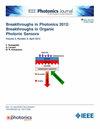数字子载波复用系统的联合光纤非线性缓解与补偿
IF 2.1
4区 工程技术
Q3 ENGINEERING, ELECTRICAL & ELECTRONIC
引用次数: 0
摘要
光纤非线性是光通信系统的瓶颈,通常通过应用各种非线性减缓和补偿技术来解决。一般来说,非线性缓解技术能以最小的计算复杂度带来适度的改进,而非线性补偿技术则能以更高的计算复杂度为代价带来显著的性能提升。这促使我们提出一种联合非线性缓解和补偿方法,在这种方法中,信号传播过程中的非线性效应被削弱,从而以较低的复杂度补偿残余非线性。具体来说,本文研究了偏振多路复用、数字子载波多路复用和波分复用(PM-DSCM-WDM)光通信系统的预色散补偿(pre-CDC)传输中符号率优化(SRO)和基于扰动的非线性补偿(PB-NLC)的组合。我们强调了 SRO 和 PB-NLC 之间的相互作用,并证明与在传统 PM-WDM 系统中仅应用 PB-NLC 相比,联合 SRO 和 PB-NLC 可带来可观的性能增益,显著降低复杂性,并为平衡性能与复杂性之间的权衡提供了额外的自由度。我们观察到,预 CDC 传输具有独特的特性,能够在发射器和接收器之间分配 PB-NLC 的计算复杂度。利用这一独特特性,我们为 PM-DSCM-WDM 系统提出了一种 PB-NLC 分离技术。该技术结合了前 PB-NLC 和后 PB-NLC 的优点,在保持与后 PB-NLC 相同的计算复杂度的同时,还能适度提高性能。本文章由计算机程序翻译,如有差异,请以英文原文为准。
Joint Fiber Nonlinearity Mitigation and Compensation for Digital Sub-Carrier Multiplexing System
Fiber nonlinearity is the bottleneck of optical communication systems and is commonly addressed by applying various nonlinearity mitigation and compensation techniques. In general, nonlinearity mitigation techniques offer modest improvements with minimal computational complexity, while nonlinearity compensation techniques provide significant performance gains at the expense of higher computational complexity. This motivates us to propose a joint nonlinearity mitigation and compensation approach in which the nonlinear effects during signal propagation are reduced to compensate for the residual nonlinearity at a lower complexity. Specifically, in this paper, we study the combination of symbol rate optimization (SRO) and perturbation-based nonlinearity compensation (PB-NLC) for a pre-chromatic dispersion compensated (pre-CDC) transmission of polarization multiplexing, digital sub-carrier multiplexing, and wavelength division multiplexing (PM-DSCM-WDM) optical communication system. We highlight the interplay between SRO and PB-NLC and demonstrate that joint SRO and PB-NLC provides considerable performance gain, significant complexity reduction, and an additional degree of freedom to balance performance-complexity trade-offs when compared to applying only PB-NLC in a conventional PM-WDM system. We observe that the pre-CDC transmission manifests a unique property that enables the distribution of PB-NLC computational complexity between transmitter and receiver. Leveraging the distinctive property, we propose a split PB-NLC technique for the PM-DSCM-WDM system. This technique combines the benefits of both pre-PB-NLC and post-PB-NLC, resulting in a modest performance improvement while maintaining the same computational complexity as post-PB-NLC.
求助全文
通过发布文献求助,成功后即可免费获取论文全文。
去求助
来源期刊

IEEE Photonics Journal
ENGINEERING, ELECTRICAL & ELECTRONIC-OPTICS
CiteScore
4.50
自引率
8.30%
发文量
489
审稿时长
1.4 months
期刊介绍:
Breakthroughs in the generation of light and in its control and utilization have given rise to the field of Photonics, a rapidly expanding area of science and technology with major technological and economic impact. Photonics integrates quantum electronics and optics to accelerate progress in the generation of novel photon sources and in their utilization in emerging applications at the micro and nano scales spanning from the far-infrared/THz to the x-ray region of the electromagnetic spectrum. IEEE Photonics Journal is an online-only journal dedicated to the rapid disclosure of top-quality peer-reviewed research at the forefront of all areas of photonics. Contributions addressing issues ranging from fundamental understanding to emerging technologies and applications are within the scope of the Journal. The Journal includes topics in: Photon sources from far infrared to X-rays, Photonics materials and engineered photonic structures, Integrated optics and optoelectronic, Ultrafast, attosecond, high field and short wavelength photonics, Biophotonics, including DNA photonics, Nanophotonics, Magnetophotonics, Fundamentals of light propagation and interaction; nonlinear effects, Optical data storage, Fiber optics and optical communications devices, systems, and technologies, Micro Opto Electro Mechanical Systems (MOEMS), Microwave photonics, Optical Sensors.
 求助内容:
求助内容: 应助结果提醒方式:
应助结果提醒方式:


